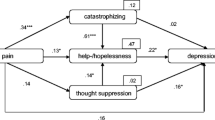Abstract
Cognitive-behavioral models of chronic pain emphasize the importance of situation specific as well as more general cognitive variables as mediators of emotional and behavioral reactions to nociceptive sensations and physical impairment. The relationship of situation-specific pain-related self-statements, convictions of personal control, pain severity, and disability levels was assessed in samples of chronic back pain and rheumatoid arthritis patients. Both the more general and the situation-specific sets of cognitive variables were more highly related to pain and disability than disease-related variables. This association was found in the back pain patients who displayed only marginal levels of organic findings as well as the rheumatoid arthritis sample who had a documented basis for their pain. The combination of both situation-specific and general cognitive variables explained between 32 and 60% of the variance in pain and disability, respectively. The addition of disease-related variables improved the predictions only marginally. These results lend support to the importance of cognitive factors in chronic pain syndromes.
Similar content being viewed by others
References
Averill, J. R. (1973). Personal control over aversive stimuli and its relationship to stress.Psychol. Bull. 80: 286–303.
Bandura, A. (1977). Self-efficacy: Toward a unifying theory of behavioral change.Psychol. Rev. 84: 191–215.
Beck, A. T. (1976).Cognitive Therapy and Emotional Disorders, International Universities Press, New York.
Beck, A. T., and Weismann, A. (1974). The measurement of pessimism: The Hopelessness Scale.J. Consult. Clin. Psychol. 42: 861–865.
Biedermann, H. J., McGhie, A., Monga, T. N., and Shanks, G. L. (1987). Perceived and actual control in EMG treatment of back pain.Behav. Res. Ther. 25: 137–147.
Binik, Y. M. (1983). Coping with chronic life threatening illness: Psychosocial perspective on end-stage renal disease.Can. J. Behav. Sci. 15: 373–391.
Blumer, D., and Heilbronn, M. (1982). Chronic pain as a variant of depressive disease. The pain-prone disorder.J. Nerv. Ment. Dis. 170: 381–406.
Fernandez, E. (1986). A classification system of cognitive coping strategies for pain.Pain 26: 141–153.
Flor, H., Haag, G., Turk, D. C., and Koehler, H. (1983). Efficacy of EMG biofeedback, pseudo-therapy, and conventional medical treatment for chronic rheumatic back pain.Pain 17: 21–31.
Flor, H., Haag, G., and Turk, D. C. (1986). Long-term efficacy of EMG biofeedback for chronic back pain.Pain 21: 195–202.
Follick, M. J., Zitter, R. E., and Ahern, D. K. (1983). Failures in the operant treatment of pain. In Foa, E. B., and Emmelkamp, P. (eds.),Failures in Behavior Therapy, Wiley, New York.
Follick, M. J., Ahern, D. K., and Laser-Wolston, N. (1984). Evaluation of a daily activity diary for chronic pain patients.Pain 19: 373–382.
Holroyd, K. A., Penzien, D. B., Hursey, K. G., Tobin, D. L., Rogers, L., Holm, J. E., Marcille, P. J., Hall, J. R., and Chila, A. G. (1984). Change mechanisms in EMG biofeedback training. Cognitive changes underlying improvements in tension headaches.J. Consult. Clin. Psychol. 52: 1039–1059.
Kazis, L. E., Meenan, R. F., and Anderson, J. J. (1983). Pain in the rheumatic diseases. Investigation of a key health status component.Arth. Rheum. 26: 1017–1021.
Kerns, R. D., Turk, D. C., and Rudy, T. E. (1985). The Westhaven-Yale Multidimensional Pain Inventory (WHYMPI).Pain 23: 345–356.
Lefebvre, M. F. (1981). Cognitive distortion and cognitive errors in depressed psychiatric and low back pain patients.J. Consult. Clin. Psychol. 49: 517–525.
McArthur, D. L., Cohen, M. J., Gottlieb, H. J., Naliboff, B. D., and Schandler, S. L. (1987). Treating chronic low back pain. I. Admissions to initial follow-up.Pain 29: 1–22.
Meenan, R. F., Gertman, P. M., and Mason, J. H. (1980). Measuring health status in arthritis: The Arthritis Impact Measurement Scales.Arth. Rheum. 23: 146–152.
Melzack, R. (1975). The McGill Pain Questionnaire: Major properties and scoring methods.Pain 1: 277–299.
Rosenstiel, A. K., and Keefe, F. J. (1983). The use of coping strategies in chronic low back pain patients: Relationships to patient characteristics and current adjustment.Pain 17: 33–44.
Schmidt, A. J. M. (1985). Cognitive factors in the performance level of chronic low back pain patients.J. Psychosom. Res. 29: 183–189.
Skevington, S. M. (1983). Chronic pain and depression: Universal or personal helplessness.Pain 15: 309–317.
Smith, T. W., Follick, M. J., Ahern, D. K., and Adams, A. (1986). Cognitive distortion and disability in chronic low back pain.Cognit. Ther. Res. 10: 201–210.
Spanos, N. P., Radtke-Bodorik, H. L., Ferguson, J. D., and Jones, B. (1979). The effect of hypnotic susceptibility, suggestions for analgesia, and the utilization of cognitive strategies on the reduction of pain.J. Abnorm. Psychol. 88: 282–292.
Timko, C., and Janoff-Bulman, R. (1985). Attributions, vulnerability, and psychological adjustment: The case of breast cancer.Health Psychol. 4: 521–544.
Turk, D. C., and Rudy, T. E. (1986). Coping with chronic illness: The mediating role of cognitive appraisal. In McHugh, S., and Vallis, T. M. (eds.),Illness Behavior: A Multidisciplinary Model, Plenum, New York, pp. 309–320.
Turk, D. C., Meichenbaum, D. H., and Genest, M. (1983).Pain and Behavioral Medicine: A Cognitive-Behavioral Perspective, Guilford, New York.
Turner, J. A., and Chapman, C. R. (1982). Psychological interventions for chronic pain: A critical appraisal. II. Operant conditioning, hypnosis, and cognitive-behavior therapy.Pain 12: 23–46.
Turner, J. A., and Clancy, S. (1986). Strategies for coping with chronic low back pain: Relationship to pain and disability.Pain 24: 355–364.
Wallston, K. A., Wallston, B. S., and DeVellis, R. (1978). Development of the multidimensional health locus of control (MHLC) scales.Health Educ. Monogr. 6: 161–170.
Wilkinson, L. (1980).SYSTAT: The System for Statistics, SYSTAT, Evanston, Ill.
Author information
Authors and Affiliations
Additional information
Support for this research was provided to the first author by DFG (German Research Foundation) Grants Fl 156/1-1 and Fl 156/2-1 and to the second author by NIH Grant RO1 AR NS 38698-01.
Rights and permissions
About this article
Cite this article
Flor, H., Turk, D.C. Chronic back pain and rheumatoid arthritis: Predicting pain and disability from cognitive variables. J Behav Med 11, 251–265 (1988). https://doi.org/10.1007/BF00844431
Accepted:
Issue Date:
DOI: https://doi.org/10.1007/BF00844431




